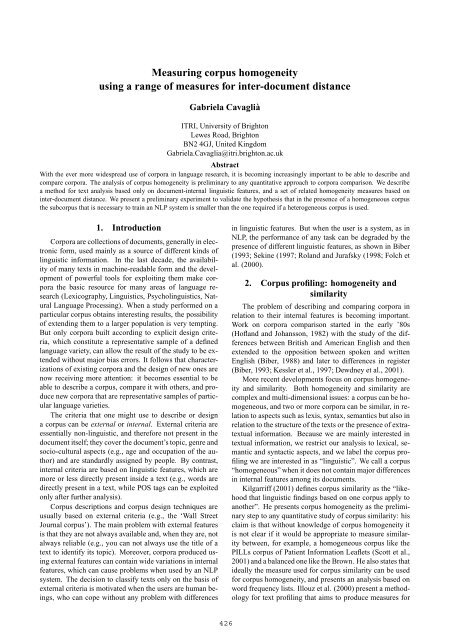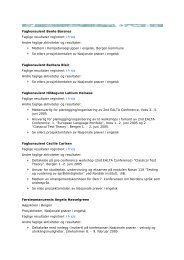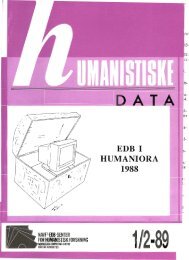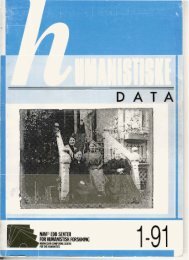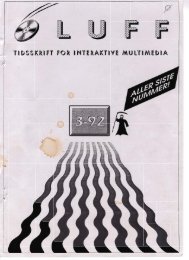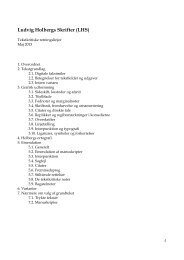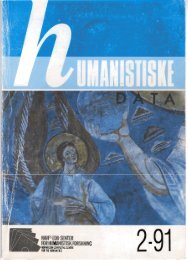Measuring corpus homogeneity using a range of measures for inter ...
Measuring corpus homogeneity using a range of measures for inter ...
Measuring corpus homogeneity using a range of measures for inter ...
You also want an ePaper? Increase the reach of your titles
YUMPU automatically turns print PDFs into web optimized ePapers that Google loves.
<strong>Measuring</strong> <strong>corpus</strong> <strong>homogeneity</strong><br />
<strong>using</strong> a <strong>range</strong> <strong>of</strong> <strong>measures</strong> <strong>for</strong> <strong>inter</strong>-document distance<br />
Gabriela Cavaglià<br />
ITRI, University <strong>of</strong> Brighton<br />
Lewes Road, Brighton<br />
BN2 4GJ, United Kingdom<br />
Gabriela.Cavaglia@itri.brighton.ac.uk<br />
Abstract<br />
With the ever more widespread use <strong>of</strong> corpora in language research, it is becoming increasingly important to be able to describe and<br />
compare corpora. The analysis <strong>of</strong> <strong>corpus</strong> <strong>homogeneity</strong> is preliminary to any quantitative approach to corpora comparison. We describe<br />
a method <strong>for</strong> text analysis based only on document-<strong>inter</strong>nal linguistic features, and a set <strong>of</strong> related <strong>homogeneity</strong> <strong>measures</strong> based on<br />
<strong>inter</strong>-document distance. We present a preliminary experiment to validate the hypothesis that in the presence <strong>of</strong> a homogeneous <strong>corpus</strong><br />
the sub<strong>corpus</strong> that is necessary to train an NLP system is smaller than the one required if a heterogeneous <strong>corpus</strong> is used.<br />
1. Introduction<br />
Corpora are collections <strong>of</strong> documents, generally in electronic<br />
<strong>for</strong>m, used mainly as a source <strong>of</strong> different kinds <strong>of</strong><br />
linguistic in<strong>for</strong>mation. In the last decade, the availability<br />
<strong>of</strong> many texts in machine-readable <strong>for</strong>m and the development<br />
<strong>of</strong> powerful tools <strong>for</strong> exploiting them make corpora<br />
the basic resource <strong>for</strong> many areas <strong>of</strong> language research<br />
(Lexicography, Linguistics, Psycholinguistics, Natural<br />
Language Processing). When a study per<strong>for</strong>med on a<br />
particular <strong>corpus</strong> obtains <strong>inter</strong>esting results, the possibility<br />
<strong>of</strong> extending them to a larger population is very tempting.<br />
But only corpora built according to explicit design criteria,<br />
which constitute a representative sample <strong>of</strong> a defined<br />
language variety, can allow the result <strong>of</strong> the study to be extended<br />
without major bias errors. It follows that characterizations<br />
<strong>of</strong> existing corpora and the design <strong>of</strong> new ones are<br />
now receiving more attention: it becomes essential to be<br />
able to describe a <strong>corpus</strong>, compare it with others, and produce<br />
new corpora that are representative samples <strong>of</strong> particular<br />
language varieties.<br />
The criteria that one might use to describe or design<br />
a <strong>corpus</strong> can be external or <strong>inter</strong>nal. External criteria are<br />
essentially non-linguistic, and there<strong>for</strong>e not present in the<br />
document itself; they cover the document’s topic, genre and<br />
socio-cultural aspects (e.g., age and occupation <strong>of</strong> the author)<br />
and are standardly assigned by people. By contrast,<br />
<strong>inter</strong>nal criteria are based on linguistic features, which are<br />
more or less directly present inside a text (e.g., words are<br />
directly present in a text, while POS tags can be exploited<br />
only after further analysis).<br />
Corpus descriptions and <strong>corpus</strong> design techniques are<br />
usually based on external criteria (e.g., the ‘Wall Street<br />
Journal <strong>corpus</strong>’). The main problem with external features<br />
is that they are not always available and, when they are, not<br />
always reliable (e.g., you can not always use the title <strong>of</strong> a<br />
text to identify its topic). Moreover, corpora produced <strong>using</strong><br />
external features can contain wide variations in <strong>inter</strong>nal<br />
features, which can cause problems when used by an NLP<br />
system. The decision to classify texts only on the basis <strong>of</strong><br />
external criteria is motivated when the users are human beings,<br />
who can cope without any problem with differences<br />
in linguistic features. But when the user is a system, as in<br />
NLP, the per<strong>for</strong>mance <strong>of</strong> any task can be degraded by the<br />
presence <strong>of</strong> different linguistic features, as shown in Biber<br />
(1993; Sekine (1997; Roland and Jurafsky (1998; Folch et<br />
al. (2000).<br />
2. Corpus pr<strong>of</strong>iling: <strong>homogeneity</strong> and<br />
similarity<br />
The problem <strong>of</strong> describing and comparing corpora in<br />
relation to their <strong>inter</strong>nal features is becoming important.<br />
Work on corpora comparison started in the early ’80s<br />
(H<strong>of</strong>land and Johansson, 1982) with the study <strong>of</strong> the differences<br />
between British and American English and then<br />
extended to the opposition between spoken and written<br />
English (Biber, 1988) and later to differences in register<br />
(Biber, 1993; Kessler et al., 1997; Dewdney et al., 2001).<br />
More recent developments focus on <strong>corpus</strong> <strong>homogeneity</strong><br />
and similarity. Both <strong>homogeneity</strong> and similarity are<br />
complex and multi-dimensional issues: a <strong>corpus</strong> can be homogeneous,<br />
and two or more corpora can be similar, in relation<br />
to aspects such as lexis, syntax, semantics but also in<br />
relation to the structure <strong>of</strong> the texts or the presence <strong>of</strong> extratextual<br />
in<strong>for</strong>mation. Because we are mainly <strong>inter</strong>ested in<br />
textual in<strong>for</strong>mation, we restrict our analysis to lexical, semantic<br />
and syntactic aspects, and we label the <strong>corpus</strong> pr<strong>of</strong>iling<br />
we are <strong>inter</strong>ested in as “linguistic”. We call a <strong>corpus</strong><br />
“homogeneous” when it does not contain major differences<br />
in <strong>inter</strong>nal features among its documents.<br />
Kilgarriff (2001) defines <strong>corpus</strong> similarity as the “likehood<br />
that linguistic findings based on one <strong>corpus</strong> apply to<br />
another”. He presents <strong>corpus</strong> <strong>homogeneity</strong> as the preliminary<br />
step to any quantitative study <strong>of</strong> <strong>corpus</strong> similarity: his<br />
claim is that without knowledge <strong>of</strong> <strong>corpus</strong> <strong>homogeneity</strong> it<br />
is not clear if it would be appropriate to measure similarity<br />
between, <strong>for</strong> example, a homogeneous <strong>corpus</strong> like the<br />
PILLs <strong>corpus</strong> <strong>of</strong> Patient In<strong>for</strong>mation Leaflets (Scott et al.,<br />
2001) and a balanced one like the Brown. He also states that<br />
ideally the measure used <strong>for</strong> <strong>corpus</strong> similarity can be used<br />
<strong>for</strong> <strong>corpus</strong> <strong>homogeneity</strong>, and presents an analysis based on<br />
word frequency lists. Illouz et al. (2000) present a methodology<br />
<strong>for</strong> text pr<strong>of</strong>iling that aims to produce <strong>measures</strong> <strong>for</strong>
<strong>corpus</strong> <strong>homogeneity</strong> within the different parts <strong>of</strong> a <strong>corpus</strong>.<br />
Their supervised approach is similar to Biber’s work on text<br />
classification, but they use a tagger/parser to analyze syntactic<br />
features.<br />
We present a technique <strong>for</strong> <strong>corpus</strong> analysis strictly<br />
based on <strong>inter</strong>nal features and unsupervised learning techniques,<br />
together with a set <strong>of</strong> <strong>measures</strong> <strong>for</strong> <strong>corpus</strong> <strong>homogeneity</strong><br />
and similarity.<br />
3. The methodology<br />
We propose a stochastic method to describe and compare<br />
corpora, which is based only on their <strong>inter</strong>nal features.<br />
This method can be computed <strong>for</strong> any <strong>corpus</strong>, and is independent<br />
<strong>of</strong> any particular theory <strong>of</strong> language: it uses all the<br />
linguistic features <strong>of</strong> the documents, and not just a special<br />
sub-set as <strong>for</strong> example in Biber’s work. The method has<br />
four steps:<br />
1. choose the aspect you want to study and the type <strong>of</strong><br />
feature you want to use;<br />
2. collect data <strong>for</strong> each document in the <strong>corpus</strong>;<br />
3. calculate the similarity between each pair <strong>of</strong> documents;<br />
4. quantify the characteristics <strong>of</strong> the <strong>corpus</strong>: we produce<br />
both a description <strong>of</strong> the <strong>corpus</strong> and <strong>measures</strong> <strong>of</strong> its<br />
<strong>homogeneity</strong> and its similarity in relation to other corpora.<br />
3.1. Deciding aspect and feature types<br />
Corpus pr<strong>of</strong>iling can be studied from different perspectives.<br />
As has been said, we restrict our <strong>inter</strong>est to linguistic<br />
analysis and in particular to the lexical, syntactic and semantic<br />
aspects. Each aspect can be studied <strong>using</strong> different<br />
feature types (i.e. words or POS tags). At the moment just<br />
the lexical and syntactic aspects have been investigated.<br />
Lexical analysis is per<strong>for</strong>med to detect possible restrictions<br />
in the vocabulary. As feature types <strong>for</strong> lexical analysis,<br />
either all-words or content words or lemmas are used.<br />
To identify restrictions at the syntactic level, either function<br />
words or POS tags or POS bi-grams are used. To detect<br />
function words a list <strong>of</strong> function words is needed, while to<br />
produce POS tag and POS bi-gram frequency lists a POS<br />
tagger is required.<br />
3.2. Collecting the data<br />
The objects employed to study <strong>corpus</strong> pr<strong>of</strong>iling are the<br />
texts that make up the <strong>corpus</strong>. Each text is represented by<br />
a vector <strong>of</strong> features (attributes) or a frequency list. A frequency<br />
list is a list <strong>of</strong> pairs ¢¡¤£¦¥¨§©¡���� in which ¡ is a feature<br />
instance, e.g., the function word “with” or the lemma<br />
“to cut”, and ¥¨§©¡�� is the frequency <strong>of</strong> the feature ¡ in the<br />
document (the number <strong>of</strong> occurrences <strong>of</strong> “with” or “to cut”<br />
in the document). Instead <strong>of</strong> <strong>using</strong> the sample<br />
¥¨§©¡��<br />
frequency<br />
direcly, we compute the estimate <strong>of</strong> the probability<br />
§©¡�� . �<br />
This step yields a matrix which represents a <strong>corpus</strong> by<br />
the frequency lists <strong>of</strong> its documents.<br />
3.3. Computing similarity<br />
Probability lists representing texts in the <strong>corpus</strong> can also<br />
be seen as distributions. Two documents are considered<br />
similar if their probability distributions are similar. We explored<br />
the use <strong>of</strong> three different text-similarity <strong>measures</strong>.<br />
Relative entropy, also know as Kullback-Leibler divergence,<br />
is a well-known measure <strong>for</strong> calculating how similar<br />
two probability distributions are (over the same event<br />
space). If � §©��� and � §©��� are the distributions which represent<br />
two documents, the relative entropy, � § �¨� � � � , is calculated<br />
as follow:<br />
§ �¨� � � ����� ��<br />
�<br />
���<br />
§©��������� � §©���<br />
� §©��� �<br />
Because it is not defined <strong>for</strong> � §©������� , <strong>for</strong> which<br />
� § �¨� � � ����� , we compute the centroid, the average probability<br />
distribution <strong>of</strong> the <strong>corpus</strong>, and then add it to each<br />
distribution be<strong>for</strong>e calculating the similarity. The <strong>for</strong>mula<br />
<strong>for</strong> relative entropy becomes:<br />
§ �¨� � � ����� ��<br />
���<br />
���<br />
� §©���¤����§©����������� � §©��������§©���<br />
§<br />
§©��������§©��� �<br />
with ��§©��� the centroid <strong>of</strong> the entire <strong>corpus</strong>.<br />
We also tested two other similarity <strong>measures</strong> based on<br />
the divergence from the null hypothesis that the two documents<br />
are random samples from the same distribution: Chi<br />
Squared and Log-likelihood.<br />
Chi Square measure (�¨� ): <strong>for</strong> each feature in the frequency<br />
list, we calculate the number <strong>of</strong> occurrences in each<br />
document that would be expected. Suppose the sizes <strong>of</strong><br />
documents A and B are respectively ��� and ��� and feature<br />
w has observed frequency ����� � in A and ����� � in B,<br />
then the expected value � ��� � <strong>for</strong> A is:<br />
��� � � ��� §������ � ������� � �<br />
��� � ���<br />
�<br />
and likewise � ��� � <strong>for</strong> <strong>for</strong> document B. Then �¨� the value<br />
<strong>for</strong> the document pair, A and B, is computed as follows:<br />
� ��� ��<br />
�<br />
���<br />
§��<br />
��� �<br />
� �<br />
�<br />
�<br />
�<br />
with the sum over all the features.<br />
(��� Log-likelihood ): Dunning (1993) showed ��� that<br />
is a much better approximation <strong>of</strong> the binomial distribution<br />
��� than especially <strong>for</strong> events with frequencies smaller than<br />
5. It is a measure that works quite well with both large and<br />
small documents and allows the comparison <strong>of</strong> the significance<br />
<strong>of</strong> both common and rare events. A Contingency<br />
table, as presented in table 1, helps us to understand the<br />
<strong>for</strong>mula ��� <strong>for</strong> .<br />
� � � � �<br />
����§����¤�¢��� ����§����¤����� ����§����¤����� ����§����<br />
�<br />
�<br />
§����<br />
�<br />
����§����¢��� �<br />
§����¢�����<br />
����§�������� §����������<br />
����§�������� §����������<br />
����§�������� §����������<br />
��§����¢������������� ����§����¢�����������
Doc. A Doc. B<br />
w a b<br />
w c d<br />
Table 1: Contingency table<br />
� ��� ��<br />
�<br />
���<br />
This step yields a similarity matrix: to each pair <strong>of</strong> documents<br />
a distance is associated. Relative entropy, ��� and<br />
� � are all distance <strong>measures</strong>, so in the matrix the more similar<br />
text couples appear with a small value assigned.<br />
3.4. Quantify <strong>homogeneity</strong><br />
The similarity values calculated in the previous step <strong>for</strong><br />
each pair <strong>of</strong> documents in a <strong>corpus</strong> are now employed to<br />
produce in<strong>for</strong>mation to help in describing the <strong>corpus</strong> and in<br />
quantifying its <strong>homogeneity</strong> and its similarity in relation to<br />
other corpora. The in<strong>for</strong>mation we provide <strong>for</strong> the <strong>corpus</strong><br />
is:<br />
¡<br />
¡<br />
¡<br />
a <strong>homogeneity</strong> measure which quantifies the variability<br />
<strong>of</strong> the features inside the <strong>corpus</strong>. The <strong>homogeneity</strong><br />
measure corresponds to the maximum distance among<br />
its documents;<br />
the <strong>corpus</strong> prototypical element, to give the user an<br />
idea <strong>of</strong> what kind <strong>of</strong> text he/she can find in the <strong>corpus</strong>.<br />
In clustering, such an object is called “the medoid”,<br />
the cluster element which is the nearest to the centroid;<br />
a similarity measure which describes the relative position<br />
<strong>of</strong> the <strong>corpus</strong> in relation to the others. The similarity<br />
<strong>of</strong> <strong>corpus</strong> A and B is the distance between their<br />
centroids.<br />
The usefulness <strong>of</strong> a prototypical element and the validity<br />
<strong>of</strong> a similarity measure depend directly on the <strong>homogeneity</strong><br />
<strong>of</strong> the corpora analyzed. The more a <strong>corpus</strong> is homogeneous<br />
the better its prototypical element can describe<br />
the <strong>corpus</strong> documents, because there is a smaller variance<br />
between it and the other documents <strong>of</strong> the <strong>corpus</strong>. The <strong>inter</strong>pretation<br />
<strong>of</strong> a similarity measure computed between a<br />
homogeneous <strong>corpus</strong> and a heterogeneous one, or between<br />
two heterogeneous corpora, is not clear, and needs further<br />
analysis. In this paper we focus only on the evaluation <strong>of</strong><br />
the <strong>homogeneity</strong> <strong>measures</strong>.<br />
� �<br />
�<br />
4. Evaluation<br />
The aim <strong>of</strong> our first experiment is to understand which<br />
text-similarity measure is most reliable, among the three<br />
currently used (� § �¨� � � � , � � and � � ).<br />
To evaluate the <strong>homogeneity</strong> <strong>of</strong> a <strong>corpus</strong> is difficult owing<br />
to the lack <strong>of</strong> gold-standard judgments with which the<br />
<strong>measures</strong> can be compared. The hypothesis at the base <strong>of</strong><br />
<strong>homogeneity</strong> is that a NLP system can reach better results<br />
when it uses an homogeneous <strong>corpus</strong> rather than an heterogeneous<br />
one. In the experiment we run an NLP system<br />
<strong>using</strong> homogeneous and heterogeneous corpora. Then we<br />
compare the accuracy that the system achieved on each <strong>corpus</strong>,<br />
with the degree <strong>of</strong> <strong>homogeneity</strong> that the <strong>corpus</strong> scores.<br />
We expect to find that the accuracy <strong>for</strong> the homogeneous<br />
corpora is higher.<br />
The NLP system we use <strong>for</strong> the evaluation is Rainbow<br />
(McCallum, 1996), which per<strong>for</strong>ms text classification. We<br />
choose Rainbow because it is freely available, fast, and<br />
does not require any particular annotation or linguistic resource<br />
other than the <strong>corpus</strong> itself. Because Rainbow per<strong>for</strong>ms<br />
text analysis (builds its model) <strong>using</strong> all words or<br />
content words, we have to restrict the evaluation to just<br />
these two <strong>inter</strong>nal features in this experiment. We collect<br />
a set <strong>of</strong> corpora <strong>for</strong> which we have a reliable classification,<br />
and compute the <strong>homogeneity</strong> measure <strong>for</strong> each <strong>corpus</strong>. For<br />
each <strong>corpus</strong> we measure <strong>homogeneity</strong> <strong>using</strong> the three <strong>inter</strong>document<br />
similarity <strong>measures</strong>. Then, <strong>for</strong> each similarity<br />
measure, we rank the corpora according to their <strong>homogeneity</strong><br />
value in increasing order, so that homogeneous corpora<br />
appear at the beginning <strong>of</strong> the list. For each <strong>of</strong> the two<br />
features, three ranked lists <strong>of</strong> <strong>homogeneity</strong> values are produced.<br />
We then use Rainbow to produce similar ranked lists;<br />
<strong>using</strong> both all-words and content words, to use as a gold<br />
standard. All the corpora <strong>for</strong> which we measure the <strong>homogeneity</strong><br />
are merged to <strong>for</strong>m a single big <strong>corpus</strong>. We then<br />
use Rainbow to classify the new big <strong>corpus</strong> <strong>using</strong> different<br />
sizes <strong>of</strong> training <strong>corpus</strong>. The task <strong>for</strong> Rainbow is to rebuild<br />
from the merged <strong>corpus</strong> all the corpora it was made <strong>of</strong>. According<br />
to our hypothesis, in order to achieve the same level<br />
<strong>of</strong> accuracy, homogeneous corpora need to be trained on a<br />
smaller sub<strong>corpus</strong> than heterogeneous corpora. The accuracy<br />
<strong>of</strong> the classification <strong>of</strong> each class is computed. Classes<br />
are then ranked in a descending order, so that the homogeneous<br />
ones appear at the beginning <strong>of</strong> the list. For each<br />
<strong>of</strong> the two features, a rank list <strong>of</strong> Rainbow accuracy values<br />
is produced. Finally, the Spearman’s rho test is employed<br />
to identify the correlation between the <strong>homogeneity</strong> values<br />
and Rainbow accuracy values.<br />
5. Experiment<br />
The <strong>corpus</strong> we used <strong>for</strong> this first experiment is the<br />
British National Corpus (BNC). The BNC is a 100 millionword<br />
collection <strong>of</strong> samples <strong>of</strong> written and spoken language,<br />
from a wide <strong>range</strong> <strong>of</strong> sources, designed to represent a wide<br />
cross-section <strong>of</strong> current British English (monolingual synchronic<br />
<strong>corpus</strong>). Moreover, it is a general <strong>corpus</strong> which<br />
includes many different language varieties, and is not limited<br />
to any particular subject field, genre or register. There<br />
has been a lot <strong>of</strong> work on the classification <strong>of</strong> BNC documents.<br />
The BNC Index (Lee, 2001) is an attempt to combine<br />
and consolidate some <strong>of</strong> these suggestions. The result<br />
is a resource which provides an accurate classification<br />
<strong>of</strong> the documents in the BNC, according to many different<br />
kinds <strong>of</strong> external criteria such as medium, domain and<br />
genre. According to the medium, BNC documents can be<br />
classified into six different classes: spoken, written-to-bespoken,<br />
book, periodical, published miscellanea, and unpublished<br />
miscellanea. For domain, spoken English can be<br />
classified into five classes (e.g., transcription <strong>of</strong> business
ecordings, spontaneous natural conversations), and written<br />
English into nine (e.g., applied science, arts, belief and<br />
thought). There are 24 genres <strong>for</strong> spoken and 46 genres <strong>for</strong><br />
written English (among the genres <strong>for</strong> written English there<br />
are <strong>for</strong> example personal letters, university essays, tabloid<br />
newspaper, bibliographies and instructional texts).<br />
To avoid comparing classes whose size is too dissimilar:<br />
¡<br />
¡<br />
each BNC document is divided into chunks <strong>of</strong> a fixed<br />
size. For the first experiment, chunks <strong>of</strong> 20,000 words<br />
were produced. If a document is too small it is discharged.<br />
If it is big enough to contain more than one<br />
chunk, multiple chunks are produced, and considered<br />
as individual documents in the analysis;<br />
<strong>for</strong> each BNC classes from medium, domain and<br />
genre, a <strong>corpus</strong> is created with the same number <strong>of</strong><br />
chunks. For the experiment we produced corpora <strong>of</strong><br />
20 chunks each. If a class does not contains enough<br />
documents it is discharged; otherwise 20 chunks are<br />
chosen randomly.<br />
This gives 51 corpora with 20 documents <strong>of</strong> 20,000<br />
words each. Three random corpora made <strong>of</strong> 20 chunks chosen<br />
randomly from the BNC are also created. We expected<br />
random corpora to be less homogeneous than all the other<br />
corpora.<br />
The three <strong>homogeneity</strong> <strong>measures</strong> (<strong>using</strong> � § �¨� � � � , � �<br />
and ��� ) <strong>for</strong> each <strong>corpus</strong> are calculated, and the corpora are<br />
ranked according to their <strong>homogeneity</strong> score: corpora with<br />
a lower score are considered more homogeneous than ones<br />
with a higher score. Then the 54 corpora are merged to<br />
<strong>for</strong>m one big <strong>corpus</strong>, and Rainbow is used to see how accurately<br />
it can recover each <strong>of</strong> the 54 corpora, <strong>using</strong> training<br />
sets <strong>of</strong> different sizes. The sizes used were 1, 5, 10, 15; e.g.,<br />
when the training set size was 5, the task <strong>for</strong> Rainbow was<br />
to recover the other 15 same-class documents out <strong>of</strong> the pot<br />
<strong>of</strong> 1080 documents. For each <strong>corpus</strong>, we compute the accuracy,<br />
the proportion <strong>of</strong> correctly classified documents, and<br />
the standard deviation calculated on 50 trials.<br />
6. Results<br />
Tables 2 and 3 list the <strong>homogeneity</strong> <strong>measures</strong> <strong>for</strong> the<br />
five corpora at the beginning and end <strong>of</strong> the lists ranked by<br />
<strong>homogeneity</strong> and Rainbow accuracy values, <strong>using</strong> all words<br />
as features. Using Rainbow, the three random corpora appear<br />
to be less homogeneous than all the other corpora,<br />
as expected. The <strong>homogeneity</strong> <strong>measures</strong> based on <strong>inter</strong>document<br />
distance instead partially failed; in fact, although<br />
they all appear somewhere at the bottom <strong>of</strong> the rank list,<br />
just one <strong>of</strong> them turns up after all the non-random corpora.<br />
We use Spearman’s rho test (Owen and Jones, 1977) to<br />
compare the ranks obtained <strong>using</strong> the <strong>homogeneity</strong> measure<br />
and Rainbow. Spearman’s correlation is when the two<br />
ranks are exacly the same, and � when no correlation is<br />
found between the two ranked lists. The results, presented<br />
in table 4 <strong>for</strong> all words and in table 5 <strong>for</strong> content words, are<br />
always positive and usually within the significance level <strong>of</strong><br />
¡£¢<br />
.<br />
� § �¨� � � � ��� ���<br />
Corpus<br />
g-W news script 0.0489 0.0304 0.0663<br />
g-W newsp tabloid 0.0948 0.0640 0.1503<br />
g-W newsp other report 0.1208 0.0817 0.1951<br />
g-W newsp other sports 0.1335 0.0750 0.1756<br />
g-W hansard 0.1459 0.0950 0.2283<br />
d-W app science 0.6165 0.2973 0.7737<br />
m-m unpub 0.6502 0.3711 0.9649<br />
g-W misc 0.6572 0.2818 0.7040<br />
g-W advert 0.7201 0.2949 0.7519<br />
random2 0.94344 0.4200 1.0906<br />
Table 2: Homogeneity scores computed <strong>using</strong> the 500 most<br />
frequent words in each <strong>corpus</strong><br />
Rainbow Homogeneity Spearman’s<br />
correlation<br />
1 doc per class � § �¨� � � � 0.526<br />
1 doc per class �¨� 0.527<br />
1 doc per class ��� 0.530<br />
5 doc per class � § �¨� � � � 0.447<br />
5 doc per class �¨� 0.473<br />
5 doc per class ��� 0.474<br />
10 doc per class � § �¨� � � � 0.432<br />
10 doc per class �¨� 0.451<br />
10 doc per class ��� 0.451<br />
15 doc per class � § �¨� � � � 0.387<br />
15 doc per class �¨� 0.413<br />
15 doc per class � � 0.415<br />
Table 4: Spearman’s correlation between Rainbow accuracy<br />
values and Homogeneity values <strong>using</strong> words<br />
7. Conclusion and future work<br />
The Spearman correlation values show that the original<br />
distinction between homogeneous and heterogeneous corpora<br />
is maintained in Rainbow: corpora with a low <strong>homogeneity</strong><br />
score need a small training set to achieve a high accuracy<br />
in the classification task. By contrast, heterogeneous<br />
and random corpora need a bigger training set to achieve an<br />
accuracy which, however, is smaller than the one obtained<br />
by the homogeneous corpora.<br />
None <strong>of</strong> the three text-similarity <strong>measures</strong> used to compute<br />
<strong>homogeneity</strong> produces a rank which follows exactly<br />
the same order identified with Rainbow, even if the constant<br />
high values <strong>of</strong> the standard deviation suggest that the rank<br />
order identify by Rainbow is not fixed. Among the three<br />
<strong>measures</strong>, ��� provides the closest rank, expecially when<br />
all words are used.<br />
Various reasons may be responsible <strong>for</strong> the unclarity <strong>of</strong><br />
the results:<br />
¡<br />
lack <strong>of</strong> data: chunks, in which we divide the documents,<br />
and the number <strong>of</strong> chunks, we set <strong>for</strong> each <strong>corpus</strong>,<br />
are not big enough. For this experiment we produce<br />
chunks <strong>of</strong> 20,000 words and we use corpora <strong>of</strong><br />
20 chunks each. We also try to use chunks <strong>of</strong> 50,000<br />
words and corpora made <strong>of</strong> 50 chunks each, but the
Class 1 5 10 15<br />
g-W hansard 73.05 (32.61) 97.2 (6.74) 97.6 (4.31) 94.8 (8.86)<br />
g-W newsp tabloid 70.52 (25.62) 89.46 (5.05) 83.4 (7.98) 85.6 (16.18)<br />
g-W ac medicine 58.63 (26.75) 85.06 (9.67) 85.4 (8.85) 80.4 (16.89)<br />
g-W newsp other sports 56.31 (21.24) 88.26 (13.57) 92.6 (8.99) 96.8 (7.40)<br />
g-W news script 53.57 (30.64) 63.73 (24.32) 71.2 (20.06) 66.4 (19.56)<br />
m-periodical 3.26 (4.36) 0 (0) 0 (0) 0 (0)<br />
m-book 2.52 (5.12) 1.86 (3.31) 0.6 (2.39) 0.8 (3.95)<br />
random3 2.42 (4.28) 0.13 (0.94) 0 (0) 0 (0)<br />
random2 2.21 (3.84) 0.26 (1.32) 0 (0) 0 (0)<br />
random1 1.05 (2.12) 0.13 (0.94) 0.6 (2.39) 0 (0)<br />
Table 3: The accuracy obtained by Rainbow analyzing all words <strong>for</strong> homogeneous and heterogeneous subcorpora <strong>using</strong><br />
training set <strong>of</strong> different size: 1, 5, 10 and 15 document per class respectively<br />
Rainbow Homogeneity Spearman’s<br />
correlation<br />
1 doc per class � § �¨� � � � 0.445<br />
1 doc per class �¨� 0.383<br />
1 doc per class ��� 0.389<br />
5 doc per class � § �¨� � � � 0.291<br />
5 doc per class �¨� 0.277<br />
5 doc per class � � 0.286<br />
10 doc per class � § �¨� � � � 0.273<br />
10 doc per class �¨� 0.269<br />
10 doc per class ��� 0.281<br />
15 doc per class � § �¨� � � � 0.240<br />
15 doc per class �¨� 0.232<br />
15 doc per class ��� 0.245<br />
Table 5: Spearman’s correlation between Rainbow accuracy<br />
values and Homogeneity values <strong>using</strong> content words<br />
¡<br />
¡<br />
¡<br />
number <strong>of</strong> BNC classes which contain these amounts<br />
<strong>of</strong> data are few and appear to be all quite heterogeneous;<br />
presence <strong>of</strong> noise in the data: at the moment we use<br />
the N most frequent <strong>inter</strong>nal features present in each<br />
<strong>corpus</strong>, and <strong>for</strong> this experiment we set N equal to 500.<br />
We would like to consider ways <strong>of</strong> identifying the features<br />
that seem more likely to show differences among<br />
the documents, and <strong>of</strong> filtering out those which instead<br />
can only create noise;<br />
the use <strong>of</strong> Rainbow as a gold-standard judgment <strong>for</strong><br />
<strong>homogeneity</strong>: to classify texts any system uses a mix<br />
<strong>of</strong> <strong>homogeneity</strong> and similarity, so the attempt to use its<br />
classification to evaluate a <strong>homogeneity</strong> measure can<br />
be misleading ;<br />
the three text similarity <strong>measures</strong> used may not be the<br />
best <strong>for</strong> studying <strong>corpus</strong> <strong>homogeneity</strong> and similarity.<br />
The results obtained from this first attempt to evaluate<br />
the <strong>homogeneity</strong> measure confirm the hypothesis that homogeneous<br />
corpora need a smaller training set than heterogeneous<br />
corpora to achieve a certain degree <strong>of</strong> accuracy.<br />
But the methodology we have used is still too unrefined to<br />
produce clear results.<br />
As far as the methodology is concerned, the aspect requiring<br />
further attention is the use <strong>of</strong> some kind <strong>of</strong> feature<br />
selection in order to analyze just the more distinctive features.<br />
At the moment we are considering different types<br />
<strong>of</strong> feature selection. We also want to use a fourth textsimilarity<br />
measure - perplexity.<br />
As far as evaluation is concerned, other experiments to<br />
study the validity and reliability <strong>of</strong> the <strong>measures</strong> proposed<br />
to quantify <strong>homogeneity</strong> and similarity are needed. Because<br />
the main applications <strong>of</strong> the two <strong>measures</strong> are in NLP,<br />
they should still be tested in relation to a NLP task. We<br />
would like to consider a different system from text classification<br />
and also possible ways <strong>of</strong> combining the two <strong>measures</strong>.<br />
8. References<br />
Douglas Biber. 1988. Variation across speech and writing.<br />
Cambridge University Press.<br />
Douglas Biber. 1993. Using register-diversified corpora<br />
<strong>for</strong> general language studies. Computational Linguistics,<br />
19(2):219–41.<br />
Nigel Dewdney, Carol VanEss-Dykema, and Richard<br />
MacMillan. 2001. The <strong>for</strong>m is the substance: Classification<br />
<strong>of</strong> genres in text. In Workshop on human<br />
language technology and knowledge management,<br />
Toulouse, France. ACL 2001.<br />
Ted Dunning. 1993. Accurate methods <strong>for</strong> the statistics<br />
<strong>of</strong> surprise and coincidence. Computational Linguistics,<br />
19(1):61–74.<br />
Helka Folch, Serge Heiden, Benoit Habert, Serge Fleury,<br />
Gabriel Illouz, Pierre Lafon, Julien Nioche, and Sophie<br />
Prevost. 2000. Typtex: Inductive typological text classification<br />
by multivariate statical analysis <strong>for</strong> nlp systems<br />
tuning/evaluation. In Second International Conference<br />
on Language Resources and Evaluation, pages 141–148,<br />
Athens, Greece. Lrec 2000.<br />
k. H<strong>of</strong>land and S. Johansson. 1982. Word frequencies in<br />
British and American English. The Norwegian Computing<br />
Centre <strong>for</strong> the Humanities.<br />
Gabriel Illouz, Benoit Habert, Helka Folch, Serge Heiden,<br />
Serge Fleury, Pierre Lafon, and Sophie Prevost. 2000.
Typtex: Generic features <strong>for</strong> text pr<strong>of</strong>iler. In Content-<br />
Based Multimedia In<strong>for</strong>mation Access, Paris, France.<br />
RIAO’2000.<br />
Brett Kessler, Ge<strong>of</strong>frey Nunberg, and Hinrich Schutze.<br />
1997. Automatic detection <strong>of</strong> text genre. In Procceedings<br />
<strong>of</strong> the 37th Annual Meeting <strong>of</strong> the Association <strong>for</strong><br />
Computational Linguistic and the 8th Conference <strong>of</strong> the<br />
European Chapter <strong>of</strong> the Association <strong>for</strong> Computational<br />
Linguistic, pages 32–38, Madrid, Spain. ACL‘97.<br />
Adam Kilgarriff. 2001. Comparing corpora. International<br />
Journal <strong>of</strong> Corpus Linguistics, 6(1):1–37.<br />
David Lee. 2001. Genres, registers, text types, domains<br />
and styles: Clarifying the concepts and navigating a path<br />
through the bnc jungle. Language Learning & Technology,<br />
5(3):37–72. Special Issue on: ”Using Corpora in<br />
Language Teaching and Learning.<br />
Andrew Kachites McCallum. 1996. Bow: A toolkit <strong>for</strong><br />
statistical language modeling,text retrieval, classification<br />
and clustering. http://www.cs.cmu.edu/ mccallum/bow.<br />
Frank Owen and Ronald Jones. 1977. Statistics. Polytech<br />
Publishers, Stockport, UK.<br />
Douglas Roland and Daniel Jurafsky. 1998. How verb subcategorization<br />
frequencies are affected by <strong>corpus</strong> choice.<br />
In 36th Annual Meeting <strong>of</strong> the Association <strong>for</strong> Computational<br />
Linguistics, pages 1122–1128, Montreal, Canada.<br />
D. Scott, N. Bouayad-Agha, R. Power, S. Schulz, R. Beck,<br />
D. Murphy, and R. Lockwood. 2001. Pills: A multilingual<br />
authoring system <strong>for</strong> patient in<strong>for</strong>mation. In Vision<br />
<strong>of</strong> the Future and Lessons from the past. Proceeding <strong>of</strong><br />
the 2001 AMIA Annual Symposium, Washington DC.<br />
Satoshi Sekine. 1997. The domain dependence <strong>of</strong> parsing.<br />
In Proceedings <strong>of</strong> the Fifth Conference on Applied Natural<br />
Language Processing, Washington D.C., USA. ACL.


